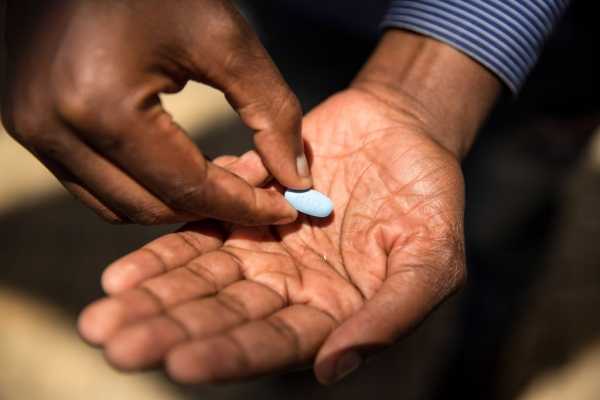
Boris*, a gay student in New York, went to his university health center in 2017 seeking a pill to prevent HIV. He was worried that condoms weren’t doing enough to keep him safe and had heard that pre-exposure prophylaxis or PrEP — the once-daily pill sold under the name Truvada — was a good idea for people with more than 10 sexual partners a year.
But his doctor was dubious about whether insurance should cover it, telling him, “I don’t know whether society should support the promiscuity of a few people.”
Even before PrEP hit the US market in 2012, there were fears that it would promote promiscuity and more risky sex. The president of the AIDS Health Foundation once called it a “party drug.” “Truvada Whore” emerged as a slut-shaming label for people who took it in the gay community.
Now there’s data showing that some concern is justified. A systematic review published in March in the journal Clinical Infectious Diseases found that some PrEP users are having more risky sex — and as a result, getting more sexually transmitted infections (STIs). The review, which brought together 17 studies on PrEP use and sexual behavior change, suggests that as people begin to trust PrEP, they’re having more condomless sex and worrying less about other STIs. The more recent studies in the review show the strongest trend.
It’s a timely finding for two reasons: PrEP is about to become more widely available, and cases of syphilis, gonorrhea, and chlamydia have lately been rising in the United States. Right now, PrEP is only available to people at the highest risk of getting HIV, including gay and bisexual men, people who engage in sex work, and people who use injection drugs. But the Food and Drug Administration just approved it for teenagers, and some experts think anybody who wants it should have access.
Though PrEP is only one of many reasons STIs are spiking, the early signs that people taking the pill are engaging in risky behavior suggests that traditional messages about condom use are failing. And it means the public health community needs to come up with better ways to help those at risk.
PrEP helps some people have more risky sex
The HIV/AIDS epidemic has killed 37 million people since it was officially recognized in 1981, but thanks to effective antiretroviral drugs, HIV is now a treatable chronic illness. Although gay and bisexual men account for just 2 percent of the population of the United States, they accounted for 70 percent of new HIV diagnoses in 2014. Recent estimates place the number of gay and bisexual men currently living with HIV in the United States at more than 600,000.
With the development of PrEP, people can take it and have sex with whomever they want, however they want, as much as they want, with essentially no risk of getting HIV. And researchers think it may be helping to reduce the number of new HIV infections. But to date, the question of how PrEP is changing people’s sexual behaviors has been an open one.
That’s what makes this new systematic review so important. The researchers only looked at unblinded studies of PrEP, meaning that the study participants knew they were taking the medication. So in effect, this review is a synthesis of the early evidence on how PrEP might influence sexual behavior in the real world.
The authors found that in some studies, PrEP use was associated with a 9 percent increase in the amount of receptive anal sex without a condom with 10 or more partners, an 11 percent increase in the amount of sex without a condom with an HIV-positive person or with someone whose HIV status was unknown, and a 14 percent increase in people never using condoms during anal sex. These are all high-risk behaviors that increase the chances of getting HIV and other STIs.
But they didn’t find any changes in the number of people who had any sex without a condom, partly because so few participants started off using condoms all the time. And this is a key point: PrEP didn’t appear to change the number of people who have sex without a condom.
But among those who already used condoms intermittently, PrEP was associated with more condomless sex and things like bottoming (receptive anal sex) more often — which carries a much greater infection risk than topping (insertive anal sex). In other words, people who were already engaging in risky sex seemed to have more of it on PrEP.
What’s more, the researchers found the risk of getting an STI increased during the period that PrEP has been on the market. Studies from before 2016, when PrEP was just starting to be used, didn’t show any increase in STIs. When the review authors looked more closely at the recent studies, the ones whose last follow-up with study participants was after 2016, they found an astonishing effect: Those on PrEP have 1.5 times the odds of acquiring an STI like chlamydia, gonorrhea, and syphilis, compared to before they started taking PrEP.
“Studies that were conducted [more recently] and with longer follow-up time are the ones where we found the most evidence for an increase in risk,” said Michael Traeger, a researcher at the Burnet Institute in Melbourne, Australia, and the lead author of the study. “We refer to this as the normalization of PrEP over time.”
Related
We need to talk about how Grindr is affecting gay men’s mental health
Boris, the college student in New York, told me about his experience using hookup apps like Grindr while on PrEP. He said that most people don’t seem to have hard and fast rules about condom use, and people were generally willing to use a condom if their partner wanted it. But he did say that he thinks that PrEP allows people to have more condomless sex, and even amongst his friend group, he noticed people who have started having more condomless sex while on PrEP.
“Just talking to people that I know, there are many more people now who have bareback sex because they’re on PrEP than there were five years ago,” Boris told me. “I would be incredibly surprised if there was no change in the frequency” of risky sex.
PrEP is only one contributor of many to the skyrocketing rates of sexually transmitted infections
The rising rates of STIs among men who have sex with men isn’t a new problem — it’s a trend that started before PrEP.
The rates of gonorrhea infection among men who have sex with men have been climbing from 3.9 percent in 1989 to 37.8 percent in 2016. In 2016 there were more than 2 million cases of syphilis, gonorrhea, and chlamydia in the United States — the highest cumulative number of cases the US has ever seen. In the same year, men who had sex with men accounted for 80 percent of all primary and secondary cases of syphilis.
Although researchers believe PrEP is a contributor, they haven’t been able to tease out the effect of PrEP from the effect of new hookup apps or the existing upward trend in STIs. “There is not much control data, so we can’t attribute it to PrEP alone,” Traeger, the new study’s lead author, told me. “So while I would say that PrEP is a contributor, it is not the only contributor.”
And while some worry that PrEP is the final license people needed to give up condoms, it’s also clear that sex without a condom was becoming more and more popular well before PrEP. So it’s difficult to tell in the context of clinical trials whether we’re seeing the continuation of this trend or a change in behavior from PrEP.
Yet despite skyrocketing rates of STIs, experts think condom use will continue to decline no matter what.
“We’ve held up a standard and applied it almost uniquely to gay men — this idea that you are supposed to use a condom for every sex act for your entire sexual lifetime,” said Jeffrey Crowley, former director of the White House Office of National AIDS Policy and a distinguished scholar at Georgetown University. “That is an unattainable standard.”
He went on: “I would say that no matter what we do, no matter how many resources we put into promoting condoms, which all remain very important, we’re still going to see a decline in condom use over time. That was even if we didn’t have PrEP.”
I asked Boris why he thought condom rates were declining. He told me that condom use seems to be correlated with the psychological nearness of the AIDS epidemic. “As time passes and HIV seems less scary, people are just less frightened into always using condoms,” he said.
While there is some truth to this — HIV is less scary than it used to be — it is still a chronic and potentially life-threatening illness. And although syphilis, gonorrhea, and chlamydia are curable with medicine, if left untreated, they can be seriously harmful. Infection with any one of these illnesses also increases your risk of acquiring other infections, including HIV, which isn’t something you want if you’re having risky sex.
So what we’re left with, post-PrEP, is a personal balancing act of risks and benefits. The medication offers additional safety from HIV infection, but it may lead some to more STIs.
PrEP needs to go hand in hand with better testing, treatment, and partner notification.
This is not to say that condoms aren’t an important tool for staying healthy. But according to Crowley, at a time where HIV can be prevented with a single daily pill, we need to move beyond expectations that men will use condoms all the time, given the fact that they are making educated choices about what is best for their health, and PrEP can prevent them from getting a life-threatening illness. “We — as people who say we care about them — we need to find better ways to value and respect the choices they’re making,” Crowley told me.
PrEP distribution needs to go hand in hand with rapid testing and treatment for infections like syphilis, gonorrhea, and chlamydia, and better education about the signs and symptoms of STIs. And we need modern methods of partner notification about STIs, like integrating anonymous notification systems into hookup apps like Grindr.
These strategies — rapid testing, treatment, and partner notification — worked well in curbing HIV infections, and they can be used to rein in the STI crisis. In fact, most people prescribed PrEP are required to undergo full STI screens every three months. If this requirement continues, the widespread distribution of PrEP could, in theory, help bring down the rates of STIs.
*Boris is a pseudonym used to protect his identity.
Dylan Collins is a Rhodes scholar who has a PhD in evidence-based medicine from Oxford University. He is currently training to be a physician in Vancouver.
Sourse: vox.com






